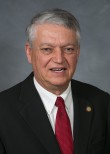PINE KNOLL SHORES – State legislators from coastal districts are considering new ways to secure money to pay for projects to help maintain wide beaches.
Building more terminal groins to try to control erosion and changing the rules for how local occupancy tax revenues may be spent may be part of the plan, Sen. Harry Brown, R-Onslow, said Thursday.
Supporter Spotlight

Speaking during the second day of the N.C. Beach, Inlet and Waterway Association’s two-day meeting at the N.C. Aquarium at Pine Knoll Shores, Brown, fellow Sen. Norm Sanderson, R-Pamlico, and Rep. Frank IIler, R-Brunswick, talked strategy and possible alliances that could help coastal counties score wins during the N.C. General Assembly’s session that begins Monday.
Brown said beach communities scored legislative wins in 2014 and 2015 with changes allowing terminal groins to be built at six inlets, but securing money for beach renourishment is always a big fight in the legislature.
“That’s always a battle for all of us,” Brown said. “Because if you don’t live on the coast, people say, ‘Why do you want to spend all of that money throwing that sand on there for it to wash away in the next storm?’ So I think what we’ve got to do is change our strategy for nourishment and I think the groin piece is part of that, when you can use nourishment to backfill those groins and stabilize it where you don’t have to do it as often.”
Environmental groups, including the N.C. Coastal Federation, oppose terminal groins because they interfere with the natural movement of sand and worsen erosion farther down the beach. Opponents also charge that the stone structures restrict the public’s use of the beach.
Brown said he “got beat up” by opponents over the groin issue, but he maintained the structures are needed, especially in his home county.
Supporter Spotlight
“If you go to New River Inlet I think you’ll see what I’m talking about. I don’t think there’s an inlet anywhere that needs it more at this point,” Brown said.
Brown said Bogue Inlet, the other inlet designated in the most recent groin legislation, isn’t wanted by the local community, which could open another location for one to be built.
“We’ll see how that plays out,” Brown said. He said “messaging” is key in the renourishment debate. “We’ve got to figure out that messaging piece.”
Beaches as Infrastructure
Part of that message may be defining beaches as part of the infrastructure of the coast. Sanderson said the association’s members get the concept and are allies with coastal legislators.
“I know there’s nobody in the room that does not totally understand importance of our beaches. It’s what brings our tourism here. It’s what creates a huge amount of revenue for the state of North Carolina,” Sanderson said, noting that beaches are “part of our infrastructure, just like an interstate highway.”
Sanderson said the solution to beach erosion problems is finding a dedicated source of money for renourishment projects.
“It’s not an easy thing to dedicate money,” he said.
Brown’s suggestion for finding that money is to revamp the rules governing how beach communities spend “tourist taxes,” the state-authorized, local occupancy taxes charged to visitors who stay in hotels, motels, cottages, condos and bed-and-breakfasts.
The formulas for how the revenues from these taxes may be spent vary from county to county. Proceeds from Carteret County’s six percent occupancy tax are split 50-50 between the county’s Tourism Development Authority for advertising and marketing purposes and the local beach commission for renourishment projects. Other counties divvy up the proceeds differently, with two-thirds going for advertising and the remaining third going for beach projects.
Brown’s suggestion to flip the allocation so that the larger portion goes to renourishment prompted a round of applause during the meeting, but the senator acknowledged that elsewhere the proposal isn’t likely to be so warmly received.
“I can tell you the lodging and tourism folks are fighting it big time,” Brown said, adding that the issue could be taken up during the upcoming session.
He said that spending the bulk of the proceeds on advertising is a bad fit for some tourist destinations.
“Some counties don’t have anything to advertise for, so why would you spend two-thirds of the money on something you don’t have anything to advertise? That makes no sense to me.” Brown said.
All About Relationships
Sanderson, during a question-and-answer period during the meeting, said coastal communities could benefit from tactics used by other special interests, such as commercial fishermen’s associations and the N.C. Pork Council.
He said hog farmers have improved their public-relations problems through heavy marketing and lobbying efforts in Raleigh and that a similar campaign could work for coastal communities.
Likewise, commercial fishermen often host a seafood dinner for legislators on the first day of the session. Sanderson called it one of the most effective lobbying efforts he’d seen.
“A lot of legislation is all about relationships,” Sanderson said.

Brown agreed. He said individual counties “won’t make a dent up there” in the state capitol.
Another key could be finding legislators who own a second home on the coast, he said.
Building a coalition with lawmakers from the western part of the state who may face similar issues resulting from the population shifts seen in recent years could also work, Brown said.
“The west is starting to feel a little bit like the east,” Brown said, noting that both ends of the state have lost population as urban areas such as Wake County grow in numbers. “We’re getting squeezed in a lot of ways. It’s important we continue to work with them on key committees and try to make things happen.”
Iler called it an “urban-rural divide.”
Sanderson said the east and the west share common interests including tourism. “Keeping sand on our beaches is exactly the same thing as in the mountains of keeping rocks off their roads,” Sanderson said.









